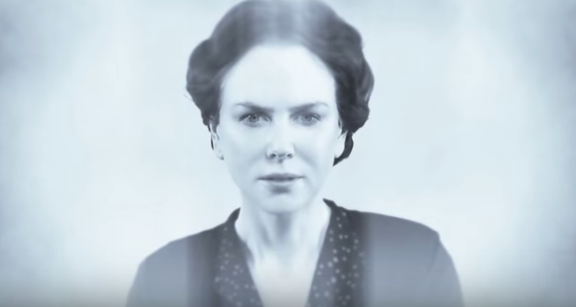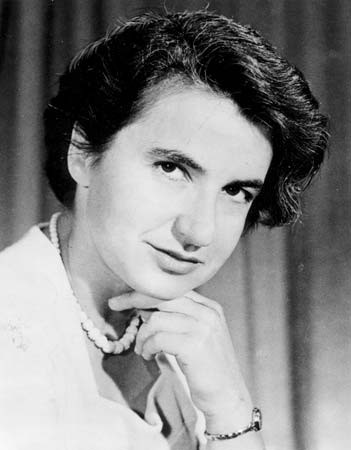Nicole Kidman in new play Photograph 51 as DNA scientist Rosalind Franklin

The Australian actress returns to the West End stage for the first time in 17 years, playing DNA scientist Rosalind Franklin. The role was a challenging one, says Kidman: "I think she was a product of that era. She was raised by a father who educated her and gave her opportunity, but he didn't want her to be a scientist - I think because he knew it wasn't going to be an easy road at all for a woman at that time, and particularly a Jewish woman," she told the Telegraph.
"She liked to work alone; she was fastidious, meticulous; she had extraordinary abilities mathematically and she was a superb biochemist, there's no doubt about that. She had problems at times working with her colleagues but to me that's perfectly understandable because of what she was up against. But she was a really committed individual to her craft, which is a beautiful thing to celebrate."
Kidman also paid a visit to Kings's College London to research her role. There is much controversy surround Franklin, who was an expert in X-ray crystallography, who was responsible for the research and discovery work that led to the understanding of deoxyribonucleic acid, DNA. Many believe she did not get the credit she deserved for her pioneering work.
Kidman visited the old laboratories where Franklin worked in the 1950s for insight into her latest role in a new West End play called Photograph 51 by Anna Zeigler, which tells the story of Franklin and her race to unlock the secret of DNA at King's College London and Cambridge University.
It was Rosalind Franklin who conceived of and captured Photograph 51 of the B form of DNA in 1952 at King's College London. This image, acquired through over 100 hours of X-ray exposure from a machine that Franklin helped develop, revealed the structure of DNA, one of the most important discoveries in modern science.
Brian Sutton, professor of molecular biophysics at King's, who answered questions about Franklin and her work, said the cast and crew were "clearly excited to be able to handle the original X-ray camera and see the original Photograph 51.
"I was happy to be able to answer their questions about the work at King's and the contributions of both Rosalind Franklin and Maurice Wilkins to the discovery of the structure of DNA," he told the Times Higher Educational supplement.
The play's director Michael Grandage said it was a "huge privilege to be given access to the extraordinary archives at King's and to view Photograph 51 itself, where our story begins".
"The experience was invaluable to us all as we prepare to bring Rosalind Franklin's story to the stage," he added.

During Kidman's visit to King's she was shown the Philips micro camera used by Franklin and fellow scientist Raymond Gosling to take Photograph 51 in 1952, a data source later used to confirm the double helix shape of DNA, as well as letters between Maurice Wilkins, Francis Crick and James Watson.
The trio later shared a Nobel Prize for Medicine in 1962 for their work on DNA four years after Franklin's death from ovarian cancer at the age of 37.
When Watson saw Photograph 51, he said: "My mouth fell open and my pulse began to race." According to the scientist it provided the clue to the double helix structure of DNA.
According to Lynne Osman Elkin, professor of biological sciences at California State University, "There is no way without her data that Watson and Crick could have figured out the structure before [her March 17th draft] got published. Now, if that had gotten published first and then they figured it out—remember, she talked about the double helix in that paper—then even though they had figured out the actual structure, they would have had to incorporate her information and credit her properly, and she would not have been written out of history."
Some believe that Franklin was her own worst enemy, with one of her closest friends Norma Sutherland saying: "Her manner was brusque and at times confrontational – she aroused quite a lot of hostility among the people she talked to, and she seemed quite insensitive to this."
Watson, who benefitted from Franklin's research rather uncharitably appraised her as a "belligerent, emotional woman unable to interpret her own data."
Others thought her an inspired and dedicated scientist. One of the researchers Franklin worked with said: "I considered her a genius, and I don't use that word lightly."

Franklin became increasingly unhappy with working at King's - Women were not allowed in the College cafeteria at the time and she was also referred to as an "assistant" rather than an independent scientist in her own right. Franklin's male peers also persisted in calling her "Rosy" or "Rosie," a nickname she disliked intensely. She moved to Birkbeck College and during the move, Wilkins came into possession of Franklin's notes and files containing Photograph 51. Fellow scientist Wilkins, who had nicknamed her "The Dark Lady", removed the photo without her knowledge or permission and took it to show Watson and Crick.
As her biographer Brenda Maddox wrote in Nature in 2003: "She did not know that they had seen either her X-ray photograph, showing unmistakable evidence of a helical structure, or her precise measurements of the unit cell (the smallest repeating unit) of the DNA crystal. As Watson was to write candidly, "Rosy, of course, did not directly give us her data. For that matter, no one at King's realized they were in our hands."
Disillusioned, Franklin abandoned her work on DNA and turned her attention to studying virus particles. Between 1953 and 1958, she made important discoveries about the tobacco mosaic virus and polio.
She died on April 16, 1958, of ovarian cancer, possibly caused by her extensive exposure to radiation while doing X-ray crystallography work.
© Copyright IBTimes 2025. All rights reserved.






















